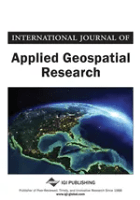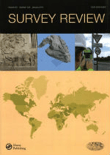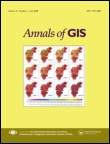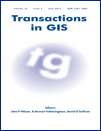
International Journal of Applied Geospatial Research
Scope & Guideline
Transforming data into actionable knowledge across disciplines.
Introduction
Aims and Scopes
- Geospatial Technology Applications:
The journal emphasizes the utilization of geospatial technologies, including GIS and remote sensing, to solve practical problems in areas such as urban planning, environmental management, and public health. - Spatial Data Analysis:
A core focus is on the analysis of spatial data using statistical methods and machine learning techniques to derive insights and patterns relevant to various research questions. - Environmental and Resource Management:
Research often addresses issues related to natural resource management, environmental monitoring, and land-use planning, highlighting the importance of geospatial data in sustainable practices. - Community and Socioeconomic Studies:
The journal includes studies that explore the intersection of geography with social sciences, examining how spatial factors influence community dynamics, health outcomes, and socioeconomic conditions. - Innovative Methodologies:
There is a consistent focus on developing and applying novel methodologies in geospatial research, such as machine learning algorithms and participatory GIS approaches.
Trending and Emerging
- Spatiotemporal Analysis:
There is a growing trend towards the analysis of changes over time and space, particularly in studies related to public health, climate change impacts, and urban dynamics, indicating the importance of temporal data in understanding spatial phenomena. - Community Engagement and Participatory Approaches:
Research that involves community engagement and participatory GIS is on the rise, highlighting the importance of local knowledge and stakeholder involvement in geospatial projects. - Integration of Machine Learning Techniques:
The application of machine learning and artificial intelligence in geospatial analysis is increasingly prominent, as researchers explore innovative ways to enhance data processing and predictive modeling. - Public Health and Epidemiological Studies:
There is an emerging focus on applying geospatial analysis to public health issues, particularly in the context of epidemics and disease spread, as seen in studies related to COVID-19. - Sustainable Resource Management:
Research addressing sustainable practices in resource management, including water conservation and land-use planning, is gaining traction, reflecting a global emphasis on sustainability.
Declining or Waning
- Traditional Land Cover Classification:
There has been a noticeable reduction in studies solely focused on traditional land cover classification techniques, as newer methods leveraging machine learning and remote sensing data become more prevalent. - General Reviews of GIS Applications:
Generic reviews of GIS applications in various fields seem to be waning, replaced by more targeted studies that apply specific methodologies to particular problems or case studies. - Static Environmental Assessments:
Research that involves static assessments of environmental conditions without incorporating dynamic or temporal analyses has become less common, as the field increasingly values spatiotemporal insights.
Similar Journals

Geomatik
Advancing geomatics for a sustainable future.Geomatik is a pioneering open-access journal dedicated to advancing the field of geomatics, encompassing disciplines such as geospatial data analysis, remote sensing, and geographic information systems. Founded in 2016 by the esteemed Geomatik Journal publisher, this peer-reviewed platform aims to disseminate high-quality research and innovative methodologies to a global audience. With its E-ISSN 2564-6761, Geomatik facilitates accessibility to cutting-edge studies that address vital challenges in environment monitoring, urban planning, and spatial data management. The journal not only encourages collaboration among researchers and practitioners but also serves as an essential resource for students seeking to deepen their understanding of geomatic sciences. Its commitment to open access fosters scholarly exchange and enhances visibility for authors, contributing to significant advancements within the geomatics community.

Revue Internationale de Geomatique
Advancing the Frontiers of Geomatics ResearchRevue Internationale de Geomatique (ISSN: 1260-5875, E-ISSN: 2116-7060) is a prestigious journal published by TECH SCIENCE PRESS, dedicated to advancing the field of geomatics. This journal serves as a vital platform for disseminating significant research findings, cutting-edge methodologies, and innovative applications within the realm of spatial data and technology. With an emphasis on interdisciplinary studies, it fosters collaboration among researchers, professionals, and students across various domains, including environmental science, urban planning, and geographic information systems (GIS). Although not an open-access journal, Revue Internationale de Geomatique maintains a rigorous peer-review process ensuring the publication of high-quality articles that contribute to the evolving landscape of geomatics. Given its relevance and commitment to scholarly excellence, this journal is a crucial resource for advancing knowledge and practices in the ever-growing field of spatial information science.

SURVEY REVIEW
Advancing Knowledge Across Engineering and Earth SciencesSURVEY REVIEW is a distinguished journal published by Taylor & Francis Ltd, focusing on a diverse range of disciplines including Civil and Structural Engineering, Computers in Earth Sciences, and Earth and Planetary Sciences. With an ISSN of 0039-6265 and an E-ISSN of 1752-2706, this journal has been a vital resource for scholarly communication since its inception in 1963. Positioned within the Q2 and Q3 quartile categories according to the latest rankings, it is recognized for its significant contributions to advancing knowledge in multiple fields, specifically holding a rank of 64/159 in Earth and Planetary Sciences and 32/73 in Computers in Earth Sciences. Researchers, professionals, and students benefit from its critical insights into complex engineering and scientific challenges. Although SURVEY REVIEW is not open access, it remains a highly cited journal, making it an essential avenue for disseminating pivotal findings that impact both academia and industry practices.

Geo-Spatial Information Science
Connecting Researchers and Practitioners through Geospatial InsightsGeo-Spatial Information Science, published by TAYLOR & FRANCIS LTD, is a premier open-access journal that has been at the forefront of disseminating cutting-edge research since its inception in 1998. With an ISSN of 1009-5020 and an E-ISSN of 1993-5153, this journal plays a pivotal role in the fields of Computers in Earth Sciences and Geography, Planning and Development, achieving a prestigious Q1 ranking in both categories as of 2023. Its exemplary Scopus rankings highlight its relevance within the social sciences and earth sciences, placing it among the top echelons of its field, with a 95th and 93rd percentile respectively. The journal aims to bridge the gap between innovative geospatial technologies and their applications in real-world scenarios, fostering interdisciplinary collaboration and advancing the global understanding of spatial data analysis. Based in the United Kingdom, Geo-Spatial Information Science invites researchers, professionals, and students to contribute and access research that shapes the future of geo-spatial sciences, all while adhering to open access principles that ensure broad dissemination and engagement with the broader academic community.

Applied Geomatics
Empowering scholars and practitioners with cutting-edge geomatic insights.Applied Geomatics is an esteemed academic journal published by SPRINGER HEIDELBERG, dedicated to advancing the field of geomatics through rigorous research and innovative applications. With an ISSN of 1866-9298 and an E-ISSN of 1866-928X, this journal has gained a prominent standing in multiple disciplines, achieving a Q2 ranking in esteemed categories such as Earth and Planetary Sciences, Engineering, Environmental Science, and Geography. The journal's convergence of research from 2009 to 2024 positions it as a vital resource for both scholars and practitioners seeking to understand and leverage geomatic technologies in real-world scenarios. Located in Germany, Applied Geomatics not only contributes to theoretical advancements but also to practical methodologies that address current environmental challenges. Its accessibility and relevance ensure that the findings discussed within its pages are pivotal for professionals, researchers, and students alike, fostering collaboration and innovation within the field.

Annals of GIS
Innovating the Future of Geographic InformationWelcome to the Annals of GIS, a leading academic journal published by Taylor & Francis Ltd, dedicated to advancing the field of Geographic Information Science and its applications. With an ISSN of 1947-5683 and an E-ISSN of 1947-5691, this Open Access journal has been ensuring wide accessibility since 2019, thereby bolstering the dissemination of knowledge in areas such as remote sensing, spatial analysis, and geoinformatics. Hailing from the United Kingdom, the journal ranks impressively within its categories, achieving a Q2 status in Computer Science Applications and a prestigious Q1 ranking in Earth and Planetary Sciences for 2023, placing it in the top 10% among its peers. With a focus on innovative research spanning from 2009 to 2024, the Annals of GIS serves as a vital platform for researchers, professionals, and students alike, providing insights and fostering discussions that push the boundaries of geographic technologies and their real-world applications.

ISPRS International Journal of Geo-Information
Transforming spatial data into actionable insights.ISPRS International Journal of Geo-Information, published by MDPI, stands at the forefront of the field of geospatial sciences, contributing valuable knowledge and research insights since its inception in 2012. This open access journal, which boasts an impressive collection of articles that emphasize the integration of geographic information systems (GIS) in Earth and planetary sciences, currently achieves a remarkable standing, with a 2023 impact factor ranking in the Q1 category for both Earth and Planetary Sciences and Geography, Planning and Development. Researchers and professionals engaged in the study of spatial data, remote sensing, and innovative geoinformation technologies will find the journal an essential resource, offering diverse perspectives and methodologies. With its open access model, the journal aims to promote the dissemination of knowledge globally, fostering collaboration among scholars while pushing the boundaries of research in geoinformation disciplines. The journal is based in Switzerland and is well-positioned to contribute significantly to the understanding and application of geospatial data for societal advancements.

Information Geographique
Pioneering Studies in Cartography and Geospatial TechnologiesInformation Geographique is a prominent academic journal dedicated to the field of geographic information science, published by the esteemed ARMAND COLIN. With its ISSN 0020-0093 and E-ISSN 1777-5876, this journal serves as a critical platform for the dissemination of innovative research, addressing the multifaceted aspects of geography and spatial analysis. Information Geographique aims to foster a deeper understanding of geographic phenomena and promote interdisciplinary dialogue among researchers, professionals, and students. Although it does not currently offer open access options, the journal's rich content encompasses studies that span from traditional cartography to cutting-edge geospatial technologies. Established in 1976, it has played a vital role in shaping the discourse within its field and continues to contribute to the academic community with thought-provoking articles and insightful analyses.

Transactions in GIS
Pioneering the Future of Geographic Research and AnalysisTransactions in GIS is a premier academic journal published by WILEY, dedicated to advancing the field of Geographic Information Science (GIS). With an ISSN of 1361-1682 and an E-ISSN of 1467-9671, this journal has continually contributed valuable insights since its inception in 1996, transforming the landscape of GIS research and application. Covering a broad scope within Earth and Planetary Sciences, it holds a notable Q2 ranking and stands in the 74th percentile among its peers as per Scopus rankings. The journal serves as a critical platform for researchers, professionals, and students who seek to disseminate and engage with innovative GIS methodologies, applications, and theoretical advancements. With a commitment to quality and rigor, Transactions in GIS remains a vital resource for those at the forefront of geographic research and analysis.

Boletim de Ciencias Geodesicas
Advancing Earth Sciences Through Open Access ResearchBoletim de Ciências Geodésicas is an esteemed academic journal published by the Universidade Federal do Paraná within its Centro Politécnico. Focused on the dynamic field of Earth and Planetary Sciences, this Open Access journal has been a pivotal resource since 1997, fostering the dissemination of critical research and innovative methodologies. With an impact factor indicative of its relevance in the discipline, Boletim de Ciências Geodésicas ranks in the Q3 quartile for Earth and Planetary Sciences as of 2023, showcasing its commitment to quality scholarship in a competitive field. Researchers and students alike will benefit from access to cutting-edge findings, given its broad scope that encompasses various aspects of geodesy and related sciences. The journal's convergence of research from 2005 to 2024 ensures that it remains at the forefront of emerging trends and fundamental developments in the discipline, further enhancing its esteemed reputation in the academic community.